Abstract
In this work, we developed a new method for the transformation of organostannanes via radical process. In this reaction, highly reactive carbon radical species can be efficiently generated through HBr-catalyzed photocleavage of C-Sn bond via single electron transfer process. Under aerobic conditions, the in situ formed primary/secondary alkyl radicals can be further highly selectively oxidized into carboxylic acids/ketones, respectively.
Introduction
C-Sn bond is known as a kind of very important carbon-metal bond, which has numerous applications in organic chemistry1,2, biological chemistry3–5, and medicinal chemistry6,7. There are three main routes for the transformation of organostannanes, including transmetalation process8–10, carbanion process11, and radical process12,13. There are lots of reports on transmetalation process. For example, the Stille cross-coupling which is a powerful tool for the formation of C-C bond has been widely applied in synthetically organic chemistry (Fig. 1a)8–10. The C-Sn bond transformation via carbanion process has also been well studied. For instance, Komatsu et al. reported that a kind of aza five-membered heterocycles could be efficiently synthesized from N-(stannylmethyl)thioamides via a ylide key intermediate (Fig. 1b)11. However, achievements via radical process are rare. In 1995, Baciocchi et al. reported the Fe-catalyzed oxidation of benzyltrialkylstannanes by iodosylbenzene, which proceeded via a radical key intermediate. However, it showed very low value in synthetic chemistry, since only a complicated mixture could be afforded as the final product (Fig. 1c)12. Obviously, research in this field remained undeveloped. We wondered whether there is a new method that can efficiently generate highly reactive carbon radical intermediate through C-Sn bond cleavage, and more importantly, the subsequent transformation of the in situ generated carbon radical intermediate should be highly selective to make such a reaction synthetically useful. In our previous work, we reported the photoinduced HBr-catalyzed C-Si bond cleavage of benzylsilanes, in which benzyl radicals could be generated and highly selectively oxidized into benzoic acids14. In this reaction, the bromine radical generated from the pre-catalyst HBr could abstract a single electron from the C-Si σ bond, which would finally break the C-Si bond and form a benzyl radical. Considering the similarity of C-Sn and C-Si bond, we assumed that benzylstannane might also be converted into benzyl radical under similar reaction conditions. If it works, we will be able to develop a new method for the transformation of organostannanes via radical process. Herein, we wish to report our recent observation in this field (Fig. 1d).
Figure 1.
Transformation of organostannanes.
Results and Discussion
Optimization and scope investigation
We conducted a series of reactions to screen the reaction conditions. Initially, the solvent effect was explored carefully. A solution of (4-methoxybenzyl)- trimethylstannane 1a (0.2 mmol) and 20 mol% of HBr (aq., 48%) in different solvents (10 mL) was irradiated by a 300 W Xe lamp at rt under air atmosphere (entries 1–5, Table 1). A mixture of 4-methoxybenzaldehyde 2a and 4-methoxybenzoic acid 3a in a very poor selectivity was afforded when CH3CN or dimethyl carbonate (DMC) was used as the solvent (entries 1 and 2, Table 1). When dichloromethane (DCM) or acetone was used as the solvent, 3a was formed as the major product in a better yield (entries 3 and 4, Table 1). To our delight, the utilization of ethyl acetate (EA) as the solvent delivered 3a as the sole product in an 89% isolated yield (entry 5, Table 1). Thus, EA was chosen as the best solvent. Next, some bromide salts of group I elements, like LiBr, NaBr, or KBr, were tested, however, all the results were not satisfactory (entries 6–8, Table 1). Decreasing the amount of HBr to 10 mol% led to a diminished yield and a much lower chemoselectivity (entry 9, Table 1). When this reaction was run in the absence of light, no product was generated (entry 10, Table 1), which indicated that light played an important role in the reaction process. Thus, Condition A (1a (0.2 mmol), 20 mol% of HBr (aq., 48%), EA (10 mL), air (1 atm), 300 W Xe lamp, quartz, and rt) was chosen as the optimized reaction condition for the following studies.
Table 1.
Optimization of reaction conditionsa.
| Entry | Catalyst (mol%) | Solvent | Time (h) | Yield (%)b | ||
|---|---|---|---|---|---|---|
| 1a | 2a | 3a | ||||

| ||||||
| 1 | HBr (20) | CH3CN | 24 | 8 | 52 | 15 |
| 2 | HBr (20) | DMC | 24 | 16 | 49 | 20 |
| 3 | HBr (20) | DCM | 24 | 0 | 2 | 59 |
| 4 | HBr (20) | Acetone | 24 | 0 | 3 | 75 |
| 5 | HBr (20) | EA | 6 | 0 | 0 | 94 (89)c |
| 6d | LiBr•H2O (20) | EA | 24 | 16 | 47 | 7 |
| 7e | NaBr (20) | EA | 24 | 16 | 53 | 20 |
| 8e | KBr (20) | EA | 24 | 0 | 6 | 69 |
| 9 | HBr (10) | EA | 24 | 14 | 38 | 24 |
| 10 f | HBr (20) | EA | 6 | 91 | 0 | 0 |
aA solution of 1a (0.2 mmol) and catalyst in the tested solvent (10 mL) in a quartz reactor was irradiated by a 300 W Xe lamp at rt under air atomsphere. bYields were determined by 1H NMR analysis (400 MHz) of the crude reaction mixture employing CH2Br2 as the internal standard. cIsolated yield of 3a. dH2O (3.8 μL) was added. eH2O (4.5 μL) was added. fThe reaction was carried out without light.
With the optimized reaction conditions in hand, we investigated the substrate scope of this reaction with a series of benzyltrimethylstannane derivatives. As shown in Table 2, the reaction showed good tolerance. Substrates with electron-donating groups were found to be reactive, giving the corresponding products in good yields (3a–e). The substrate with no substitution on the phenyl ring, like benzyltrimethylstannane 1f, was converted into 3 f in an excellent yield. Nice yields were also obtained when electron-withdrawing groups were introduced. For substrate with a weak electron-withdrawing group, like chlorine or fluorine atom, the corresponding product was isolated in good yields (3 g and 3 h). While the yields were a little lower, when the substitutions were changed into strong electron-withdrawing groups (3i–l). We were delight to see that naphthyl was also tolerant in this reaction, affording the corresponding 1- or 2-naphthoic acid, respectively (3 m and 3n). Importantly, the benzoic acid derivatives 3 were formed as the sole product in all the above tests.
Table 2.
Photooxidation of 1a–n under Condition Aa.

| ||
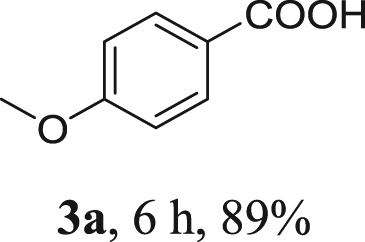
|
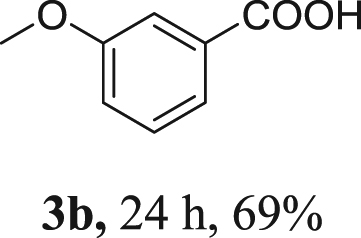
|
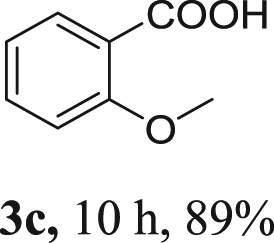
|
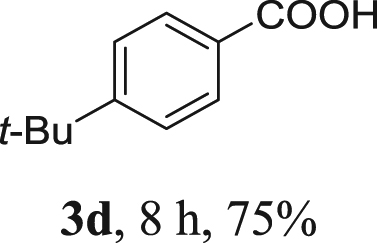
|
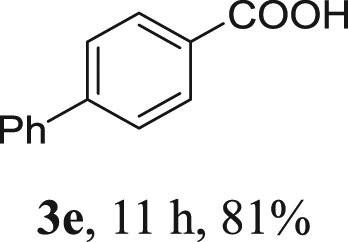
|

|

|
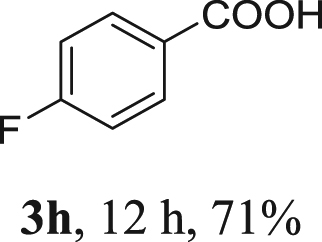
|
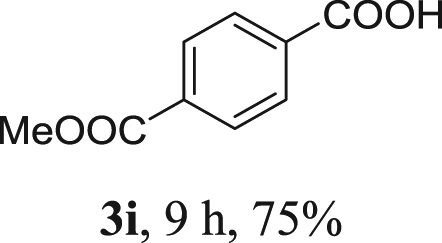
|
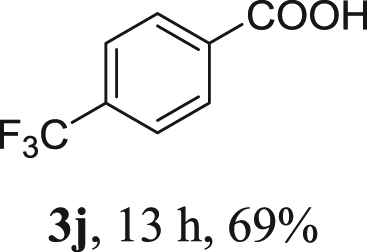
|

|
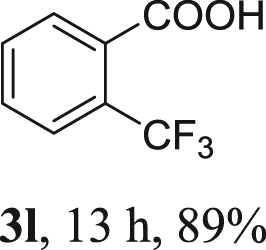
|
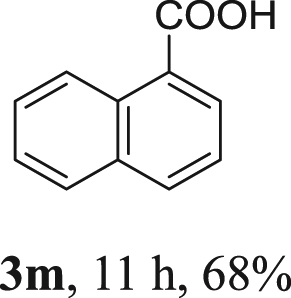
|
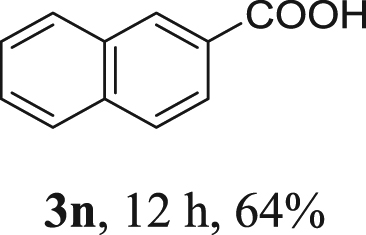
|
|
aA solution of 1 (0.2 mmol) and 20 mol% of HBr (aq., 48%) in EA (10 mL) in a quartz reactor was irradiated by a 300 W Xe lamp at rt under air atomosphere. The isolated yield was reported.
Interestingly, when trimethyl(phenethyl)stannane 1o was applied under Condition A, only benzoic acid 3f was formed in a good yield (Fig. 2). We assumed that phenylethyl radical was generated and it would be further oxidized into benzoic acid 3f as the final product.
Figure 2.

Photooxidation of 1o under Condition A.
In addition to the above primary alkyl stannanes, the reactivity of secondary alkyl stannanes were also examined. The corresponding ketones were formed as the sole product under Condition A (Fig. 3).
Figure 3.
Photooxidation of 1p and 1q under Condition A.
Mechanism studies
In order to get a better understanding of this reaction, a series of control experiments were conducted to investigate the mechanism. As shown in Table 3, the photo reaction of 1a proceeded smoothly to afford 3a in a 94% NMR yield under Condition A (entry 1, Table 3). When the reaction was carried out without light, no reaction occurred and 91% of 1a was recovered (entry 2, Table 3), which meant that light was the essential condition to start this reaction. When this reaction was run in the absence of air, 89% of 1a was recovered without any other products isolated (entry 3, Table 3), which indicated that this reaction did not proceed without air. Next, the reaction was run for only 3 h (entry 4, Table 3). In this case, 1a was not fully consumed. The corresponding benzaldehyde 2a was formed. The desired benzoic acid 3a was afforded in a low yield. This result might be a proof that benzaldehyde should be a key intermediate in the whole transformation. Then another reaction was run for 3 h under photo irradiation and a following 3 h without light (entry 5, Table 3). Almost the same result as the above test (entry 4, Table 3) was observed, which indicated that light played an important role not only in the initiation period, but also throughout the whole reaction process. Finally, the reaction was conducted without the catalyst HBr (entry 6, Table 3). The reaction speed was dramatically decreased with 46% of 1a recovered. Only 9% of 3a was yielded. Meanwhile, 46% of 2a was formed. These results clearly showed that HBr not only facilitated the C-Sn bond cleavage at the beginning of reaction, but also benefited in the following oxidation step.
Table 3.
Photo reaction of 1a under different conditionsa.
| Entry | HBr (20 mol%) | Air (1 atm) | hn (Xe lamp) | Time (h) | NMR yield (%) | ||
|---|---|---|---|---|---|---|---|
| 1a | 2a | 3a | |||||

| |||||||
| 1 | + | + | + | 6 | 0 | 0 | 94% |
| 2 | + | + | − | 6 | 91% | 0 | 0 |
| 3 | + | − | + | 6 | 89% | 0 | 0 |
| 4 | + | + | + | 3 | 46% | 43% | 10% |
| 5 | + | + | +b | 3c (6)d | 47% | 45% | 8% |
| 6 | − | + | + | 6 | 46% | 46% | 9% |
aA solution of 1a (0.2 mmol) in EA (10 mL) in a quartz reactor was irradiated by a 300 W Xe lamp at rt under air atmosphere. bThe photo irradiation was stopped after 3 h. cReaction time under photo irradiation. dTotal reaction time.
To further prove that benzaldehyde was the intermediate of this whole transformation, 2a was directly employed under Condition A. After 4 h, 3a was afforded in a 99% yield, which fully supported this inference (Fig. 4).
Figure 4.

Photo reaction of 2a under Condition A.
According to our previous work14, Br2 was formed under similar photo reaction conditions and played a key role in the catalytic process. Thus, 10 mol% of Br2 was employed instead of HBr to identify its catalytic property in this reaction. As a result, 2a was formed in a 51% yield and 3a was afforded in a 36% yield after irradiated for 6 h (Fig. 5), which indicated that Br2 could also catalyze this reaction with relatively lower efficiency.
Figure 5.
Br2-catalyzed photo reaction of 1a.
Based on the above experiment results and literature precedents14–20, a possible mechanism was proposed as shown in Fig. 6. Firstly, Br− was oxidized into Br2 by oxygen under photo irradiation14. Br2 was then photochemically converted into bromine radical15,16,21,22. In the presence of HBr, bromine radical had a relatively high oxidation potential18,23 which was strong enough to capture one electron from C-Sn σ bond of 1. Thus, the transformation of organostannanes was initiated. After being grabbed one electron from the C-Sn bond, the highly unstable radical cation 4 was formed. The subsequent heterolytic cleavage of C-Sn bond in 4 proceeded quickly to give carbon radical 5. It could be easily oxidized into benzaldehyde 2 24–26, and further oxidized into the final product benzoic acid 3 27 under Condition A.
Figure 6.

Proposed mechanism.
Conclusions
In summary, we have developed a novel method for the transformation of organostannanes via radical process. Under photo irradiation, HBr could efficiently catalyze the heterolytic cleavage of C-Sn bond in organostannanes and the subsequent highly selective oxidation. The mechanism was well studied. In this reaction, bromine acted as a medium of photochemical single electron transfer process. Such a catalyst is simple, effective, cheap, and easy to handle. Further studies in this field is in progress in our laboratory.
Methods
Synthesis of 4-methoxybenzoic acid (3a)
1a (57 mg, 0.20 mmol), EA (10 mL), and HBr (aq., 48%) (4.5 μL, 0.04 mmol) were added to a quartz reaction flask which was equipped with a magnetic stirrer and a condenser. The mixture was irradiated by a Xe lamp (300 W) at rt in the open air. The photoreaction was completed after 6 hours as monitored by TLC (eluent: petroleum ether: ethyl acetate = 10:1). The solvent was removed and the residue was purified by flash chromatography on silica gel (eluent: petroleum ether: ethyl acetate = 3:1) to afford 3a as a solid (27 mg, 89%); 1H NMR (400 MHz, CDCl3) δ 8.07 (d, J = 8.4 Hz, 2 H), 6.95 (d, J = 8.4 Hz, 2 H), 3.88 (s, 3 H).
Electronic supplementary material
Acknowledgements
We greatly acknowledge the financial support from International Science & Technology Cooperation Program of China (2014DFE40130).
Author Contributions
Conceived and designed the experiments: Xinqi Hao and Hao Guo. Performed the experiments: Han Li, Ruiwen Jin and Yawei Li. Analyzed the data: Han Li, Ruiwen Jin, Yawei Li and Aishun Ding. Contributed reagents/materials/analysis tools: Aishun Ding and Hao Guo. Wrote the paper: Han Li, Ruiwen Jin and Hao Guo.
Competing Interests
The authors declare that they have no competing interests.
Footnotes
Han Li and Ruiwen Jin contributed equally to this work.
Electronic supplementary material
Supplementary information accompanies this paper at 10.1038/s41598-017-16806-3.
Publisher's note: Springer Nature remains neutral with regard to jurisdictional claims in published maps and institutional affiliations.
Contributor Information
Xinqi Hao, Email: xqhao@zzu.edu.cn.
Hao Guo, Email: Hao_Guo@fudan.edu.cn.
References
- 1.Li L, Wang C, Huang R, Biscoe MR. Stereoretentive Pd-catalysed Stille cross-coupling reactions of secondary alkyl azastannatranes and aryl halides. Nature Chem. 2013;5:607. doi: 10.1038/nchem.1652. [DOI] [PMC free article] [PubMed] [Google Scholar]
- 2.Kells KW, Chong JM. Stille coupling of stereochemically defined r-sulfonamidoorganostannanes. J. Am. Chem. Soc. 2004;126:15666–15667. doi: 10.1021/ja044354s. [DOI] [PubMed] [Google Scholar]
- 3.Reiss A, Maier ME. Toward leiodermatolide: synthesis of the core structure. Org. Lett. 2016;18:3146–3149. doi: 10.1021/acs.orglett.6b01355. [DOI] [PubMed] [Google Scholar]
- 4.Dias LC, L EC., Jr. Total Synthesis of (−)-Marinisporolide. J. Org. Chem. 2017;82:3019–3045. doi: 10.1021/acs.joc.7b00023. [DOI] [PubMed] [Google Scholar]
- 5.Sankaranarayana PM, Pushpa LS. Designing of some novel metallo antibiotics tuning biochemical behaviour towards therapeutics: synthesis, characterisation and pharmacological studies of metal complexes of cefixime. J. Saudi Chem. Soc. 2016;20:60–66. doi: 10.1016/j.jscs.2012.09.004. [DOI] [Google Scholar]
- 6.Li H, Chen Q, Lu Z, Li A. Total syntheses of aflavazole and 14-hydroxyaflavinine. J. Am. Chem. Soc. 2016;138:15555–15558. doi: 10.1021/jacs.6b10880. [DOI] [PubMed] [Google Scholar]
- 7.Qi N, et al. Asymmetric total syntheses of aetheramides and their stereoisomers: stereochemical assignment of aetheramides. Org. Lett. 2016;18:4718–4721. doi: 10.1021/acs.orglett.6b02371. [DOI] [PubMed] [Google Scholar]
- 8.Stille JK. The palladium-catalyzed cross-coupling reactions of organotin reagents with organic electrophiles. Angew. Chem., Int. Ed. Engl. 1986;25:508–524. doi: 10.1002/anie.198605081. [DOI] [Google Scholar]
- 9.Espinet P, Echavarren AM. The mechanisms of the Stille reaction. Angew. Chem. Int. Ed. 2004;43:4704–4734. doi: 10.1002/anie.200300638. [DOI] [PubMed] [Google Scholar]
- 10.Cordovilla C, Bartolome C, Martínez-Ilarduya J, Espinet P. The Stille reaction, 38 years later. ACS Catal. 2015;5:3040–3053. doi: 10.1021/acscatal.5b00448. [DOI] [Google Scholar]
- 11.Komatsu M, Kasano Y, Yonemori J, Oderaotoshi Y, Minakata S. Unprecedented 1,4-stannatropy: effective generation of azomethine ylides as nitrile ylide equivalents from N-(stannylmethyl)thioamides. Chem. Commun. 2006;5:526–528. doi: 10.1039/B513413G. [DOI] [PubMed] [Google Scholar]
- 12.Baciocchi E, Ioele M. Oxidation of benzyltrialkylstannanes by iodosylbenzene catalyzed by iron tetrakis(pentafluoropheny1)porphyrin chloride. Possible role of benzyloxy radicals. J. Org. Chem. 1995;60:5504–5508. doi: 10.1021/jo00122a032. [DOI] [Google Scholar]
- 13.Alizadeh MH, Razavi H, Bamoharrama FF, Daneshvar K. The oxidative cleavage of carbon–tin bond catalyzed by heteropolyacids of molybdenum. J. Mol. Cata. A-Chem. 2003;206:89–96. doi: 10.1016/S1381-1169(03)00251-6. [DOI] [Google Scholar]
- 14.Sun J, et al. Photoinduced HBr-catalyzed C–Si bond cleavage of benzylsilanes and their subsequent oxidation into benzoic acids with air as the terminal oxidant. Org. Chem. Front. 2014;1:1201–1204. doi: 10.1039/C4QO00229F. [DOI] [Google Scholar]
- 15.Hirashima S, Itoh A. Photo-oxidation of aldehydes with molecular oxygen in the presence of catalytic bromine or hydrobromic acid. Chem. Pharm. Bull. 2007;55:156–158. doi: 10.1248/cpb.55.156. [DOI] [PubMed] [Google Scholar]
- 16.Sugai T, Itoh A. Aerobic photo-oxidation in the presence of catalytic allylbromide. Tetrahedron Lett. 2007;48:2931–2934. doi: 10.1016/j.tetlet.2007.02.060. [DOI] [Google Scholar]
- 17.Vidhya SN, Balasundaram ON, Chandramohan M. Structural and optical investigations of gallium doped tin oxide thin films prepared by spray pyrolysis. J. Saudi Chem. Soc. 2016;20:703–710. doi: 10.1016/j.jscs.2015.01.006. [DOI] [Google Scholar]
- 18.Eberson L. Reactivity and structure concepts in organic chemistry. Adv. Phys. Org. Chem. 1982;18:79. [Google Scholar]
- 19.Cermenati L, Mella M, Albini A. Titanium dioxide photocatalysed alkylation of maleic acid derivatives. Tetrahedron. 1998;54:2575–2582. doi: 10.1016/S0040-4020(98)00020-9. [DOI] [Google Scholar]
- 20.Bondock S, Gieman H, El-Shafei Selective synthesis, structural studies and antitumor evaluation of some novel unsymmetrical 1-hetaryl-4-(2-chloroquinolin-3-yl)azines. J. Saudi Chem. Soc. 2016;20:695–702. doi: 10.1016/j.jscs.2015.01.005. [DOI] [Google Scholar]
- 21.Baciocchi E, Crescenzi M, Giacco TD. Bromine-induced photochemical protodesilylation of benzyltrimethylsilanes by hydrogen bromide. J. Chem. Soc., Perkin Trans. 1991;1(12):3377–3378. doi: 10.1039/p19910003377. [DOI] [Google Scholar]
- 22.Ding A, Xie R, Gu G, Sun J. Bromo-catalyzed photo esterification of benzylsilanes with alcohols under aerobic conditions. J. Saudi Chem. Soc. 2017;21:245–249. doi: 10.1016/j.jscs.2016.10.001. [DOI] [Google Scholar]
- 23.Baciocchi E, Crescenzi M. Solvent and structure effects in the photobromination of benzyltrimethylsilanes. A mechanistic changeover from hydrogen-atom transfer to electron transfer. Angew. Chem., Int. Ed. Engl. 1990;29:658–659. doi: 10.1002/anie.199006581. [DOI] [Google Scholar]
- 24.Tamai T, Mizuno K, Hashida I, Otsuji Y. Photoinduced electron-transfer reactions of arylmethyl-substituted 14 group compounds: photoarylmethylation and photooxygenation. Bull. Chem. Soc. Jpn. 1993;66:3747–3754. doi: 10.1246/bcsj.66.3747. [DOI] [Google Scholar]
- 25.Sugai T, Itoh A. Aerobic photo-oxidation in the presence of catalytic allylbromide. Tetrahedron Lett. 2007;48:2931–2934. doi: 10.1016/j.tetlet.2007.02.060. [DOI] [Google Scholar]
- 26.Cermenati L, Fagnoni M, Albini A. TiO2-photocatalyzed reactions of some benzylic donors. Can. J. Chem. 2003;81:560–566. doi: 10.1139/v03-048. [DOI] [Google Scholar]
- 27.For other bromide-catalyzed aerobic photooxidation of benzaldehydes into benzoic acids, see: Hirashima, S. & Itoh, A. Facile aerobic photo-oxidation of aldehydes in the presence of catalytic lithium bromide. Chem. Pharm. Bull. 54, 1457–1458 (2006). [DOI] [PubMed]
Associated Data
This section collects any data citations, data availability statements, or supplementary materials included in this article.





